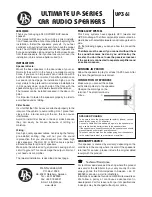
Realized Line Arrays/Horizontal Geometry
Figure 30
represents two possible methods of orienting a
full bandwith line array. The two methods are axis symmetric
and axis asymmetric. The most common realization is that of
an axis symmetric. It is the left hand drawing on
Figure 30
.
The high frequency section is in the horizontal center of the
enclosure and is flanked by two mid drivers of 6 to 8 inch
diameter and two low frequency drivers of 12 inch to 15-inch
diameter (depending on individual realization).
One of the advantages of an axis symmetric design is that
horizontal response is the same either side of the center axis.
Figure 31
slows a close up of an axis symmetric design. Of
course one of the consequences for axis symmetry is that
devices now become horizontal “arrays”. For most of this paper
we’ve focused our discussions on vertical orientation of arrays,
but it should be remembered that the same directional
response characteristics exist for devices whether they are
oriented vertically or horizontally.
There is a common mistake in sound reinforcement prac-
tice for people who normally understand that stacking devices
vertically will control the vertical pattern to then stack devices
horizontally in the misguided attempt to increase the horizontal
radiation pattern. This is something termed array arithmetic.
In normal arithmetic, 40 + 40 + 40 will always equal 120. This,
unfortunately, is not always the case with acoustics. In the
same example, three enclosures stacked horizontally are usually
done so because the array designer or the person developing
the array has a desire to cover an included angle of 120
degrees (an example). The three 40 degree devices stacked
horizontally will add to 120 degrees under certain conditions.
They will also add to 20 degrees when the wavelengths are
comparable to the spacing between the devices. This, again,
takes us back to the exact discussions we’ve seen earlier in
this paper with regards to vertical stacking. It should be
remembered by all designers that stacking, whether the arrays
are horizontal or vertical, will always narrow the pattern in
the axis that the devices are oriented. This brings us back to
the mid range devices and low frequency devices in an axis
symmetric design. These axis symmetric designs are small
horizontal arrays.
Figure 32
shows two eight inch drivers separated by a
one-inch exit vertical slot for high frequency radiation. The
two mid devices are oriented into a 90 degree included angle,
but this spacing results in a horizontal array that exhibits the
polar performance illustrated in
Figure 33
. When a cross over
frequency of 1250 Hz is used, the response is basically 6 dB
down at 30 degrees off axis generating an included angle of
60 degrees, not the 90 degrees desired by the designer of the
product. This is the result of the classic “horizontal array” and
will always occur when the crossover point is comparable to
the device spacing. This, of course, can be eliminated by taking
the crossover frequency substantially lower. Unfortunately,
compression driver performance, in terms of mechanically
generated distortion products and device reliability are severely
compromised in the 700 to 800 region that is required for this
type of device spacing. This is a classic trade-off seen often in
acoustics where one parameter is optimized at the expense of
a second parameter.
In this case, to achieve proper horizontal radiation and
the desired included angle, the distortion, fidelity and
reliability of the compression drivers are compromised; in order
to produce proper fidelity, polar response is compromised.
An alternate approach is the axis asymmetric design also
shown in
Figure 30
. In this design, there are no horizontal
arrays. The trade-off, of course, is that the device voicing is
not the same on the left hand side of the system as the right
hand side. This, however, can be seen as a minor trade-off
because the horizontal pattern is substantially improved and as
a result, stereo imaging is enhanced. It has often been argued
Figure 30
Figure 31
9































